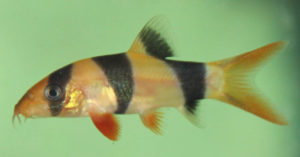Family Cobitidae
pH 6.0 – 8.0
dH 4 – 12
Temp 22 – 30 degrees
Life Span 20+ years
Origin
The Clown Loach comes from the islands of Borneo and Sumatra in Indonesia. The river systems they live in are clean and fast flowing, making them well aerated.
Description
The distinct colouring of 3 black stripes over an orange body make it easy to identify this fish with the orange colouring varying slightly from region to region. They can grow up to 40cm in length but will usually grow to around 15 – 20cm in the aquarium. The body shape of a Clown Loach is long and streamlined making them ideal swimmers.
Environment
They prefer softer acidic water, but can adapt to changes in the aquarium. Be sure to have a tank that is fully cycled before adding clown loaches. They have very little scales over their body which makes them very sensitive to any sudden parameter changes – also being sensitive to bright light. To also help minimise cuts or abrasions remove any sharp objects from the tank and use a less porous substrate.
The Clown Loach is a non aggressive bottom dweller with a playful nature that can be kept well in a community tank with other non aggressive fish. When keeping Clown Loaches, give them adequate hiding places. Use rocks, driftwood & plants to provide enough covered spaces for them to reside or sleep in. Provide a strong current for them to swim against, mimicking their natural environment. A minimum tank length of 4ft should be kept in mind when purchasing this type of fish.
Behaviour
It is suggestible to keep them in a group of 3 or more. They love to play around together and will form a hierarchy when in a group. The Clown Loach also has a moveable spike just below their eye which can be used while forming this hierarchy or if they feel the need to protect themselves from other fish. When in a group they love to swim up vertically and topple back down over each other. This seems to keep them entertained for hours on end. One of their unique qualities is to lie on their side while sleeping. When first seeing this type of behaviour, it could be taken as they are sick or dead, but this is natural for them. Clicking sounds can be heard when they are eating.
Food
They are omnivores and can eat a range of different foods. Some of these foods are flake, sinking pellets, wafers, blood worms, dried worms, brine shrimp, cucumber, zucchini, peas.
Clown Loaches are a suitable choice for reducing the snail numbers of the aquarium. The unique barbells above their mouths are perfect for reaching into the shells and extracting them. This is only suitable when they are smaller in size. Once grown into an adult, they lose the ability to penetrate such a small opening.
Disease
Clown Loaches are susceptible to white spot and because of their sensitive skin, care should be taken when using medications.
Breeding
There have been no documented cases of breeding in the aquarium but some say it can be achieved.

